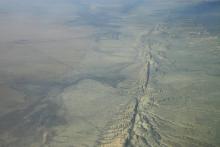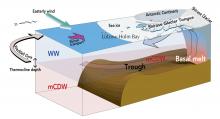Earth Sciences
News
06 Oct 2020
Tohoku University researchers have improved a method for probing semiconducting crystals with light to detect defects and impurities. The details of their 'omnidirectional photoluminescence (ODPL) spectroscopy' set-up were published in the journal Applied Physics Express, and could help improve the fabrication of materials for electric cars and solar cells.
29 Sep 2020
China’s success in improving air quality by cutting polluting emissions may have a negative knock-on effect on climate change overall, a new study has found.

29 Sep 2020
Climate warming will alter marine community compositions as species are expected to shift poleward, significantly impacting the Arctic marine ecosystem.
27 Sep 2020
Researchers have shaken up a once accepted timeline for cataclysmic events in the early solar system. Geological and geochemical records indicate that the Earth-Moon system experienced a period of frequent and cataclysmic impacts from asteroids and other bodies. It was thought that this period had a relatively sudden onset, but the researchers have found evidence that this bombardment period may have started much earlier, and decreased in intensity over time.
24 Sep 2020
Nestled at the base of a scenic mountain range in the northeast part of Hong Kong, the campus of The Education University of Hong Kong (EdUHK) is rich in biodiversity. Members of the University community recorded over 1,270 observations of 380 species of trees, plants, insects, birds, fungi and reptiles in the worldwide City Nature Challenge 2019.
21 Sep 2020
Looking for experts who can comment on natural disasters when they occur, or disaster planning and research? We have compiled a list of experts from across Asia prepared to speak with journalists on a wide range of disaster types and issues.
17 Sep 2020
An international consortium of researchers under the aegis of CMIP6 has calculated new estimates for the melting of Earth’s ice sheets due to greenhouse gas emissions and its impact on sea levels, showing that the ice sheets could together contribute more than 40 cm by the end of 2100.
01 Sep 2020
Researchers from the Earth System Science Programme at The Chinese University of Hong Kong (CUHK) have revealed that slow earthquakes, a new type of earthquake discovered about 20 years ago, follow similar scaling relations as regular earthquakes, e.g. rate of aftershocks and formula that relates an earthquake’s energy release with how long it lasts. This discovery opens a pathway for scientists to use these events as easy-to-study analogs to probe the physics governing the power and timing of devastating earthquakes, generating a clearer picture of how energy is released with time along faults.
24 Aug 2020
Ice is melting at a surprisingly fast rate underneath Shirase Glacier Tongue in East Antarctica due to the continuing influx of warm seawater into the Lützow-Holm Bay.
24 Aug 2020
Hong Kong has been experiencing hotter summers and more scorcher days in recent years due to climate change and heat island effect. Amid the increasing number of “hot nights”, it is found that consecutive “hot nights” are more detrimental to human health than “very hot days”, although the actual temperature does not reach the level of daytime, according to a collaborative research conducted by the Institute of Future Cities at The Chinese University of Hong Kong (CUHK), as well as researchers from the University of Hong Kong.
The research also identified that lack of urban greenery and poor air ventilation in a high-density context are factors that lead to more “hot nights” than “hot days” in some areas. The team suggests that better urban planning and building design are long-term mitigation measures.
07 Aug 2020
A group of researchers from three Japanese universities has discovered why the western subarctic Pacific Ocean, which accounts for only 6 percent of the world’s oceans, produces an estimated 26 percent of the world’s marine resources.
30 Jul 2020
In a recently published paper in Earth and Planetary Science Letters, researchers from the Geodynamics Research Center, Ehime University and the University of Lille combine numerical modeling of dislocation glide and results from diffusion experiments to revisit the rheology of wadsleyite, ringwoodite and majorite garnet under geological strain rates across the transition zone of the Earth’s mantle based on theoretical plasticity modeling.
28 Jul 2020
A decade ago, a fish feed pellet made from food waste was just a concept. Today, although still in its initial stages, it is a patented marketable product with many different benefits.
27 Jul 2020
Large improvements of air quality in China during the COVID-19 lockdown have been widely reported, but new research reveals that the two pollutants most harmful to human health, fine particulate matter (PM2.5) and ozone, were only slightly reduced.
17 Jul 2020
Scientists have found the interstellar organic matter could produce an abundant supply of water by heating, suggesting that organic matter could be the source of terrestrial water.
16 Jul 2020
A research led by the Department of Geography at Hong Kong Baptist University (HKBU) has revealed that the observed average moving speed (or translation speed) of tropical cyclones making landfall over the coast of China dropped by 11% between 1961 and 2017. These slow-moving tropical cyclones brought about 20% more local total rainfall on average when compared with fast-moving ones, resulting in greater flood risks in the region.
16 Jul 2020
The past is often the window to our future, especially when it comes to natural disasters. Using data from the 2018 floods that struck southwestern Japan to calibrate a machine learning model, researchers from the International Research Institute of Disaster Science (IRIDeS) at Tohoku University and the Japan-Peru Center for Earthquake Engineering Research and Disaster Mitigation (CISMID, in Spanish), have successfully identified the flooding caused by Typhoon Hagibis.
06 Jul 2020
Low oxygen levels in water (hypoxia) pose a significant threat to marine and freshwater ecosystems worldwide, as highlighted in the latest research findings of The Education University of Hong Kong (EdUHK) in an article titled “Low oxygen levels affect reproductive function in female fish – across multiple generations”, featured in Science for Environment Policy (Issue 536). This novel finding shows that hypoxia not only impairs reproduction in female fish (Oryzias melastigma), but the adverse effects can be passed on to their descendants in subsequent generations, posing a long-term threat to the sustainability of natural fish populations around the world.
02 Jul 2020
An international collaborative study led by Professor Derrick Yuk Fo Lai at The Chinese University of Hong Kong (CUHK), joined by top-tier scientists from around the world, has discovered that sustained methane emissions from the subtropical estuarine mangroves can reduce its climatic cooling effects by over 50%, over a period of 20 years. The team produced the world’s first-ever multi-year dataset of ecosystem-scale methane emissions from a subtropical estuarine mangrove based on the data collected at Mai Po Nature Reserve in Hong Kong, which points out that global warming and greater river runoff may lead to increasing methane emissions. The findings have recently been published in Global Change Biology, a top-tier journal in the field of biodiversity conservation and environmental science.
22 Jun 2020
The first State Key Laboratory of The Education University of Hong Kong (EdUHK) was opened in June 2018, in alignment with the University’s ongoing efforts to promote environmental studies as a discipline complementary to education. As a consortium member of the State Key Laboratory of Marine Pollution (SKLMP), the University’s role is to conduct pioneering research pertaining to solving imminent marine pollution problems that pose a significant threat to our environment and public health.
03 Jun 2020
The present study screened known and unknown organohalogen compounds present in mussel and sediment samples from Hiroshima Bay. The results provided scientific evidence that unknown mixed halogenated compounds are ubiquitous in the coastal environment and possess bioaccumulative potential as high as persistent organic pollutants.
25 May 2020
Even though the deeper layers of the ocean are warming at a slower pace than the surface, animals living in the deep ocean are more exposed to climate warming and will face increasing challenges to maintain their preferred thermal habitats in the future.
25 May 2020
Wastewater could be used as a surveillance tool to monitor the invasion, spread and eradication of COVID-19 in communities.
23 Apr 2020
An international research team has revealed that this ‘super-rotation’ is maintained near the equator by atmospheric tidal waves formed from solar heating on the planet’s dayside and cooling on its nightside.

21 Apr 2020
Researchers who have shown great courage and integrity in standing up for science and scientific reasoning can be nominated until 11 May 2020

21 Apr 2020
Springer Nature Group commits to be net carbon neutral this year, as part of an ongoing reduction in emissions and broader responsible business programme.

21 Apr 2020
Communications Materials and Communications Earth & Environment join Springer Nature’s comprehensive portfolio of around 600 open access journals
14 Apr 2020
A theoretical mineral physics approach based on the ab initio methods was adopted to determine the viscosity of hexagonal, close-packed iron at the extreme pressures and temperatures corresponding to the Earth’s inner core. The results are found to deny geophysical observations of large fluctuations in the inner core rotation rate. The obtained viscosity also rules out inner core translation and provides support that the dynamics of the inner core may be governed by solid-state convection.
09 Apr 2020
A research team led by Professor Amos Tai, Associate Professor of the Earth System Science Programme at The Chinese University of Hong Kong (CUHK), has successfully quantified and visualised the impact of Hong Kong air pollution especially ozone pollutant on plants and the environment. Although the experiment took place in a rural area and in Spring, which would usually have a lower average ozone concentration, the pollutant level still reached high enough to do significant damage to the bioindicator plant. The finding was recently published in Atmosphere.
09 Mar 2020
A recent study, affiliated with South Korea's Ulsan National Institute of Science and Technology (UNIST) has developed high‐efficiency, solution‐processed, hybrid series, tandem photovoltaic devices featuring CQDs and organic bulk heterojunction (BHJ) photoactive materials.
Events
Sorry, nothing coming up for this discipline
Researchers
Sorry, nothing coming up for this discipline
Giants in history
Sorry, nothing coming up for this discipline

























